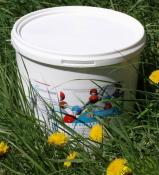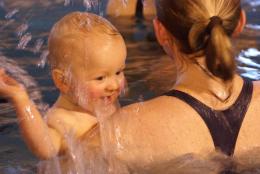Search
Login
Recommended
Disinfection of pool water without chlorine. How to ionize water with silver
A pleasant swim in the pool can only be ensured with high-quality water treatment. First of all, water should be filtered, but this procedure will not be enough - water should be purified at the molecular level. For such disinfection of liquids, various methods are used, they differ in the principle of exposure to microorganisms and bacteria, have different cost and method of disinfection.
Content
- Methods for disinfecting pool water without using chlorine
- What is water ionization? video
- Disinfection of pool water by ionization and its benefits video
- Varieties of ionizers used to disinfect water video
- Disinfection of water in the home pool by ionization
Water Disinfection Methods

Depending on the operating conditions of the pools and the requirements for water purity, the following disinfection methods can be used in them:
- reagent, involving the use of traditional chlorination, ozonation, oligodynamics, the use of bromine or active oxygen;
- reagent-free, implying the processing of water by electric pulse discharges, ultrasound, laser or ionizing radiation, ultraviolet light;
- combined, consisting in the successful combination of water treatment with reagent and non-reagent methods, the mixed method is especially effective if one of the disinfectants remains active for a long period of time.
What is water ionization?

Disinfection of water in the pool today is increasingly carried out by modern methods, including the process of water ionization. The principle of this cleaning method consists in the separation of copper and silver ions in a device mounted in the filtration system under the influence of low currents passing in the electrode block. In addition to the electrolysis method mentioned, a mechanical method for treating water is sometimes used. In any case, the released silver ions fall into the pool water and eliminate the bacteria that are in it, while copper ions prevent the development of algae. Water as a result of processing retains its properties for a long period of time.
Disinfection of pool water by ionization and its benefits

Among the advantages of the method can be noted:
- prolonged period of action - silver ions retain their activity for a long time and contribute to the purification of water, this allows to reduce the amount of chemicals used in combined purification, including chlorine,
- with the combined effects of an ozonizer and a water ionizer in pools of small capacity, you can refuse to treat it with chlorine-containing preparations,
- silver ionized water is quite suitable for drinking, it does not irritate the skin and mucous membranes, does not cause allergic symptoms, has no unpleasant odor,
- under the influence of copper ions, the smallest particles clogging the water stick together and form fractions of such a magnitude that the filters can hold.
Unfortunately, the ionization method has disadvantages:
- the effect exerted on the human body by ions cannot be considered fully understood, since silver belongs to heavy metals, its excessive accumulation in the body can cause diseases,
- ionization is not always combined with other methods of water treatment,
- the need for water treatment with chlorine-containing preparations in large pools remains.
Varieties of ionizers used to disinfect water

All ionizers, depending on the power, can be divided into domestic and industrial. They consist of water supply and enrichment systems, an electrolytic unit, a drainage system, and a housing. More powerful industrial models have several connected units with powerful electrolysis containers. Such devices are used, due to their power and considerable size, in large public pools.
Household ionizers are more modest in size and are used in artificial reservoirs with a capacity of less than 60 cubic meters. They cannot provide sufficient water treatment themselves, but reduce the use of chemicals by almost 80%. The bromine or chlorine commonly used in cleaning liquids can be replaced with substances containing active oxygen.
Disinfection of water in the home pool by ionization

You can buy a device for producing silver-enriched water in a ready-made form, in the trading network you can find many models of ionizers. But the principle of operation of the devices is quite simple, ionization of water with silver can be carried out on a device made by own hands. Materials for this will need a little. The assembly diagram can be seen in the figure.

To make the device you will need: a glass jar, two metal electrodes, fasteners for their fixation on the lid of the jar. The connection of one of the electrodes, the cathode, is performed directly, the other, the anode, will need to be connected through a diode.
During the operation of the device, dead water, anolyte, will collect around the positive electrode. It will need to be removed from the can, anolyte can be collected by attaching a bag of thin dense tarpaulin to the electrode. The main part of the device is electrodes; for their manufacture, food stainless steel, lead or aluminum with a thickness of about 1 mm can be used. You can also purchase finished carbon electrodes. The length of the electrode should be determined depending on the depth of the can, in which the ionization process will take place - they should not touch the bottom of the can and be 1-2 cm from it. A cut is made on the positive electrode on which the bag to collect the anolyte will be fixed. The positive pole is connected to the anode, and the negative pole to the cathode.

You can fix the electrodes on the most ordinary plastic cover, it is advisable to use an insulating reinforcing gasket. For its manufacture, you can take textolite or any plastic. In addition to the holes for mounting the electrodes on the lid, holes are made for the exit of gases.
Instead of a diode, a rectifier bridge can be used in the device circuit. This will increase the power of the ionizer and significantly accelerate the process of water preparation.
After assembling the device, copper and silver chips are poured onto the banks bottom, water is poured, the anode is immersed with a bag filled with water attached to it. The water in the jar should not reach the lid and be below the top edge of the canvas bag. The water preparation process will take about 10 minutes. Then the device should be switched off. Next, you need to carefully remove the bag from the can - it will accumulate liquid enriched in light non-metallic components. Since carefully removing a bag of water from a can can be problematic, you can use home-made devices made of two plastic containers without necks, for example, cut-off bottles from under mineral water. The electrodes are used the same as in the above described version, but they will need to be installed one at a time in each of the containers.
An important point will be to ensure contact between the containers, for this you can use a thick cotton cord, wrapped in a wide bandage. The tow is pre-saturated with water. A wet tow will be a good conductor of electric current, ionized particles will also pass through it. In a bank with a cathode, water with silver and copper ions will accumulate.
The reaction occurring on the inclusion field of the device will lead to the release of copper and silver ions, this will cause the destruction of some of the copper and silver chips placed in the vessels. the rest of it can be used in the following reactions.
In order not to doubt that the process has completed, you can connect the structure to the network not directly, but through a 15-watt light bulb. It is used as an indicator - with the active passage of the process, its glow will be bright, then the brightness will begin to decline. When the light goes out, the process can be considered completed. Activated water is ready.
The precipitate formed on the vessels can be removed with a solution of citric acid; after acid treatment, the jar needs to be washed with clean water.
Before ionization, water should be cleaned with a filter or let it settle.

The resulting concentrated solution of copper and silver is poured into the pool. To disinfect 10 cubic meters of water, an electrolytic solution prepared in a 2 liter bottle of water from 5 g of copper chips and 1 g of silver is enough. Such a solution is more saturated than that obtained on industrially manufactured ionizers. To obtain high-quality water, additional use of chemicals is not required. The activity of silver ions lasts about 15 days, it is recommended to repeat water treatment at least 1 time per month.
Similar requirements for the frequency of processing apply to industrial ionizers, which usually combine the ionization of water with silver and its treatment with ultraviolet rays or ozone. But the most used option today is still the complex treatment of water with silver ions and chlorine. The use of ozonation in conjunction with ionization is not particularly widespread due to the relatively high cost of equipment.





